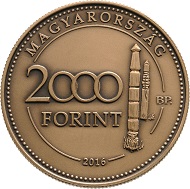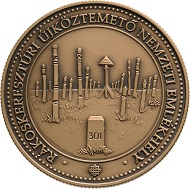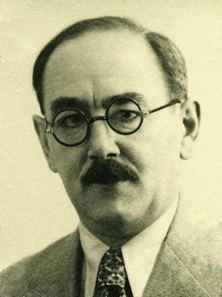January 19, 2017 – Marking the 60th anniversary of the 1956 revolution, the Magyar Nemzeti Bank is issuing a HUF 2,000 bronze patinated commemorative coin, as the third member of its series “National Memorial Sites”.
Hungary / HUF 2,000 / Cu90Zn10 / 18.4g / 37mm / Design: Sandor Kligl / Mintage: 5,000.
The front of the coin shows two stylised grave posts, recalling the markers at plots 298 and 301. The legend on the back of the coin reads “RAKOSKERESZTURI UJKÖZTEMETO NEMZETI EMLEKHELY” – New Public Cemetery, Budapest, National Memorial Site –, with the double knot symbol of the national memorial sites. The centre depicts the stone marking plot 301, with grave posts in the background. The coin was designed by Sandor Kligl.
Imre Nagy, Chairman of the Council of Ministers of the People’s Republic of Hungary, was finally buried in plot 301 after having been executed in 1958. Photo: FORTEPAN/Janosi Katalin adomanyozo / Wikimedia Commons / CC BY-SA 4.0.
Budapest New Public Cemetery
In the New Public Cemetery, plots 298, 300 and 301 are memorials to post-1945 Hungarian history, as these are the final resting places of many politicians, soldiers, public figures, everyday people and students who were condemned and executed on false charges in sham trials after 1945 and 1956.
In the years before 1990, the memorial site was the scene of silent protests against the ruling powers, recalling the spirit of 1956. Nowadays, it is one of the most important symbolic sites in post-war Hungarian history, a place of national remembrance and mourning and a memorial to the 1956 revolution.
Originally opened in 1886, it is Hungary’s largest cemetery, with an area of just over two square kilometres, divided into 301 plots. The last of these, plot 301, is the most famous. It is situated next to plot 298 and plot 300, the latter of which started to be used during the political changes in 1989. Together these three plots form the national memorial site known as the Park of National Mourning, which has complex and often difficult meanings.
Of the three plots, plot 301 has become the most famous, as a symbolic memorial site to the revolution of 1956. Starting from 1952 until plot 298 was filled, plot 301 was used as the final resting place of those executed in Budapest and the victims of the prisons in Budapest and the internment camp at Kistarcsa. The largest group of graves in this plot is for the victims of the reprisals in the wake of the 1956 revolution. 301 different carved wooden grave posts were placed at the site in 1989. The 1956 Martyrs’ Memorial, which was designed by György Jovanovics and opened in 1992, is located in plot 300, which is still used for burials to this day. Most of the posts at plot 298 are symbolic markers, but actual graves are also found there: starting in 1944 the plot was initially used for public health funerals, and then later for political victims and those who died in prison.
The three plots became a national memorial site in 2012.
More information on these and other issues is available here.
To access the official website of the New Public Cemetery, please click here.
And to learn more about the 1956 events, please visit the 1956 Institute – Oral History Archive website.







